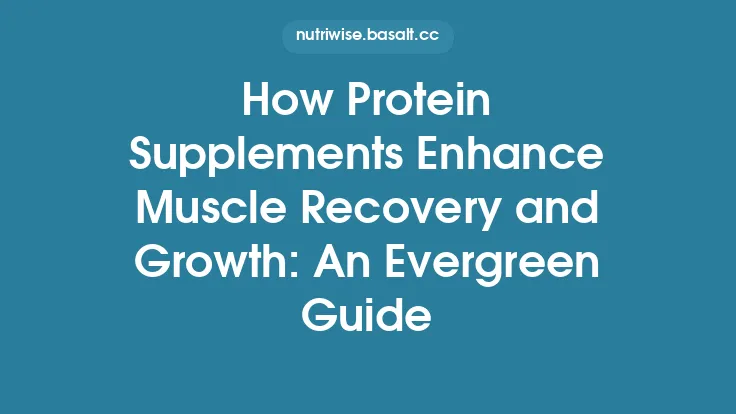Adolescence is a dynamic period marked by rapid physical growth, profound hormonal shifts, and evolving cognitive abilities. During these years—roughly ages 10 to 19—the body’s demand for vitamins and minerals spikes as it builds new tissue, expands bone mass, and supports the onset of sexual maturity. Ensuring that adolescents receive adequate micronutrients is therefore essential not only for reaching their full height and strength potential but also for establishing lifelong health patterns. This article delves into the specific micronutrient needs of teens, explains why those nutrients are critical during growth and hormonal change, and offers practical guidance for meeting those needs through diet and, when necessary, supplementation.
Growth Spurts and Hormonal Milestones: Why Micronutrients Matter
The adolescent growth spurt typically begins around ages 11–13 for girls and 13–15 for boys, lasting 2–3 years. During this window, linear growth can average 5–10 cm per year, and lean body mass may increase by 5–10 kg. Simultaneously, the endocrine system ramps up production of sex steroids (estrogen, testosterone), growth hormone, and thyroid hormones—all of which rely on specific micronutrients as cofactors or regulators.
- Bone mineralization accelerates as estrogen and testosterone stimulate osteoblast activity. Calcium, phosphorus, magnesium, vitamin‚ÄØD, and vitamin‚ÄØK are directly involved in forming hydroxyapatite crystals and regulating bone turnover.
- Hemoglobin synthesis must keep pace with expanding blood volume. Iron, copper, and vitamin‚ÄØB6 are indispensable for erythropoiesis.
- Neurotransmitter production and myelination, crucial for executive function and emotional regulation, depend on B‚Äëvitamins (especially B12, B6, folate) and zinc.
- Thyroid hormone metabolism, which influences basal metabolic rate and brain development, requires iodine and selenium.
A shortfall in any of these micronutrients can blunt growth velocity, delay puberty, impair bone density, or precipitate fatigue and cognitive difficulties—effects that may persist into adulthood.
Key Micronutrients for Adolescent Development
Below is a concise yet comprehensive look at the micronutrients most pivotal during adolescence, including their physiological roles, recommended intakes, and primary food sources.
Iron
- Role: Integral component of hemoglobin, myoglobin, and numerous enzymes; supports oxygen transport and energy metabolism.
- RDA (U.S. values): 11 mg/day for girls 12–14 y, 15 mg/day for girls 15–18 y (to offset menstrual losses); 11 mg/day for boys 12–18 y.
- Sources: Heme iron—lean red meat, poultry, fish; non‑heme iron—legumes, fortified cereals, spinach, pumpkin seeds. Vitamin C‑rich foods (citrus, bell peppers) enhance non‑heme absorption.
Calcium and Vitamin‚ÄØD
- Role: Calcium provides the structural matrix for bone; vitamin‚ÄØD (calciferol) facilitates intestinal calcium absorption and modulates bone remodeling.
- RDA: 1,300 mg/day calcium; 600 IU (15 µg) vitamin D for ages 9–18 y (higher latitudes may require 800–1,000 IU).
- Sources: Dairy (milk, yogurt, cheese), fortified plant milks, sardines with bones, tofu set with calcium sulfate, leafy greens (kale, bok choy). Vitamin D—fatty fish (salmon, mackerel), egg yolk, fortified foods, and safe sun exposure (10–30 min midday, 2–3 times/week depending on skin type).
Zinc
- Role: Cofactor for over 300 enzymes; essential for DNA synthesis, immune function, and testosterone production.
- RDA: 8 mg/day for girls, 11 mg/day for boys (12–18 y).
- Sources: Red meat, poultry, oysters, beans, nuts (cashews, almonds), whole grains, dairy. Phytates in whole grains can inhibit zinc absorption; soaking, sprouting, or fermenting grains reduces this effect.
Iodine
- Role: Critical for synthesis of thyroid hormones (T‚ÇÉ, T‚ÇÑ) that regulate metabolism and neurodevelopment.
- RDA: 150 µg/day (ages 12–18 y).
- Sources: Iodized salt, seaweed (nori, kelp), dairy, fish, eggs. Excessive seaweed can lead to iodine overload; moderation is key.
B‚ÄëComplex Vitamins
| Vitamin | Primary Functions | RDA (adolescents) | Key Foods |
|---|---|---|---|
| B1 (Thiamine) | Carbohydrate metabolism, nerve function | 0.9‚ÄØmg (girls), 1.0‚ÄØmg (boys) | Whole grains, pork, legumes |
| B2 (Riboflavin) | Energy production, antioxidant defense | 0.9‚ÄØmg (girls), 1.0‚ÄØmg (boys) | Dairy, eggs, leafy greens |
| B3 (Niacin) | DNA repair, skin health | 14‚ÄØmg (girls), 16‚ÄØmg (boys) | Poultry, fish, peanuts |
| B5 (Pantothenic acid) | Synthesis of co‚Äëenzyme A | 5‚ÄØmg (both) | Almost all foods; especially liver, mushrooms |
| B6 (Pyridoxine) | Amino‚Äëacid metabolism, neurotransmitter synthesis | 1.2‚ÄØmg (girls), 1.3‚ÄØmg (boys) | Chickpeas, bananas, fish |
| B7 (Biotin) | Fatty‑acid synthesis, gene regulation | 30 µg (both) | Egg yolk, nuts, seeds |
| B9 (Folate) | DNA synthesis, cell division | 400 µg DFE (both) | Dark leafy greens, legumes, fortified grains |
| B12 (Cobalamin) | Red blood cell formation, neurologic function | 2.4 µg (both) | Animal products; fortified plant milks for vegans |
Vitamins‚ÄØA,‚ÄØC,‚ÄØE,‚ÄØand‚ÄØK
- Vitamin A (Retinol/β‑carotene): Supports vision, immune function, and epithelial integrity. RDA: 600 µg RAE (girls), 900 µg RAE (boys). Sources: Liver, carrots, sweet potatoes, fortified dairy.
- Vitamin‚ÄØC (Ascorbic acid): Antioxidant, collagen synthesis, enhances non‚Äëheme iron absorption. RDA: 650‚ÄØmg (girls), 750‚ÄØmg (boys). Sources: Citrus fruits, strawberries, bell peppers, broccoli.
- Vitamin E (α‑tocopherol): Protects cell membranes from oxidative damage. RDA: 15 mg (both). Sources: Nuts, seeds, vegetable oils, spinach.
- Vitamin K (K₁ & K₂): Essential for blood clotting and bone mineralization. AI: 75 µg (girls), 90 µg (boys). Sources: Leafy greens (kale, collard greens), fermented foods (natto), dairy.
Magnesium and Selenium
- Magnesium: Cofactor in >300 enzymatic reactions, including ATP production and DNA repair. RDA: 310‚ÄØmg (girls), 400‚ÄØmg (boys). Sources: Nuts, seeds, whole grains, legumes, dark chocolate.
- Selenium: Integral to selenoproteins that regulate thyroid hormone metabolism and antioxidant defenses. RDA: 55 µg (both). Sources: Brazil nuts (1–2 nuts meet the requirement), seafood, whole grains.
Gender‚ÄëSpecific Nutrient Considerations
While many micronutrient needs overlap, certain differences arise due to physiological variations:
- Iron: Girls experience menstrual blood loss from menarche onward, raising their iron requirement by ~2–3 mg/day compared with boys. Monitoring ferritin levels is advisable, especially for athletes or those with heavy periods.
- Calcium & Vitamin‚ÄØD: Both sexes need high calcium for peak bone mass, but girls often have lower dietary calcium intake and may be more prone to vitamin‚ÄØD insufficiency due to indoor lifestyles.
- Zinc: Boys generally require more zinc, reflecting higher lean‚Äëmass accretion and testosterone synthesis.
- Iodine: No gender difference in requirement, but adolescent girls who are pregnant later in life may benefit from establishing adequate iodine stores early.
Recommended Intakes and How They Evolve Through Adolescence
Micronutrient recommendations are not static; they adjust as the adolescent progresses through early (10–13 y), middle (14–16 y), and late (17–19 y) phases. Below is a simplified progression for a few key nutrients (values are U.S. RDAs unless otherwise noted):
| Nutrient | Early Adolescence (10–13) | Middle Adolescence (14–16) | Late Adolescence (17–19) |
|---|---|---|---|
| Iron (girls) | 8‚ÄØmg | 11‚ÄØmg | 15‚ÄØmg |
| Iron (boys) | 8‚ÄØmg | 11‚ÄØmg | 11‚ÄØmg |
| Calcium | 1,300‚ÄØmg | 1,300‚ÄØmg | 1,300‚ÄØmg |
| Vitamin‚ÄØD | 600‚ÄØIU | 600‚ÄØIU | 600‚ÄØIU |
| Zinc (girls) | 8‚ÄØmg | 8‚ÄØmg | 8‚ÄØmg |
| Zinc (boys) | 11‚ÄØmg | 11‚ÄØmg | 11‚ÄØmg |
| Iodine | 150 µg | 150 µg | 150 µg |
| Folate | 400 µg DFE | 400 µg DFE | 400 µg DFE |
These values reflect the heightened needs for bone mineralization and hematologic expansion. Health professionals should reassess dietary intake at least annually, adjusting for growth velocity, menstrual status, and any medical conditions that affect absorption (e.g., celiac disease, inflammatory bowel disease).
Bioavailability, Interactions, and Factors Influencing Absorption
Understanding how nutrients are absorbed and utilized can help maximize their effectiveness:
- Iron: Heme iron absorption (~15–35 %) is far superior to non‑heme iron (~2–20 %). Vitamin C can increase non‑heme absorption by up to 4‑fold, while calcium, polyphenols (tea, coffee), and phytates inhibit it.
- Calcium: Vitamin‚ÄØD status is the primary determinant of calcium absorption efficiency. High sodium intake can increase urinary calcium loss.
- Zinc: Phytate binds zinc; a phytate:zinc molar ratio >15:1 markedly reduces absorption. Fermentation or sprouting of grains reduces phytate content.
- Iodine: Excessive intake of goitrogenic foods (cruciferous vegetables, soy) can interfere with thyroid iodine uptake, especially when iodine status is marginal. Cooking deactivates most goitrogens.
- Vitamin‚ÄØB12: Requires intrinsic factor for intestinal absorption; pernicious anemia is rare in adolescents but can occur in those with autoimmune conditions.
- Fat‚Äësoluble vitamins (A,‚ÄØD,‚ÄØE,‚ÄØK): Require dietary fat for optimal absorption; low‚Äëfat diets may compromise status.
Common Deficiency Risks and Signs to Watch For
| Nutrient | At‚ÄëRisk Groups | Early Clinical Indicators |
|---|---|---|
| Iron | Girls after menarche, vegetarians, low‚Äëmeat eaters | Fatigue, pallor, reduced exercise tolerance, pica |
| Calcium/Vitamin‚ÄØD | Indoor adolescents, those with limited dairy intake, darker skin (reduced UV synthesis) | Bone pain, frequent fractures, muscle weakness |
| Zinc | Vegans, high‚Äëphytate diets, chronic diarrhea | Delayed wound healing, taste abnormalities, growth retardation |
| Iodine | Low‚Äëiodine regions, restrictive diets lacking iodized salt | Goiter, slowed growth, cognitive difficulties |
| Vitamin‚ÄØB12 | Strict vegans, malabsorption syndromes | Numbness, tingling, anemia, mood changes |
| Folate | Poor intake of leafy greens, alcohol use | Macrocytic anemia, glossitis |
Routine screening (e.g., hemoglobin, ferritin, serum 25‚Äëhydroxyvitamin‚ÄØD) is advisable for adolescents with risk factors or presenting symptoms.
Dietary Patterns and Practical Food Sources
A balanced, varied diet naturally supplies most micronutrients. Below are sample meal ideas that pack a micronutrient punch:
- Breakfast: Greek yogurt parfait with fortified granola, mixed berries, and a drizzle of pumpkin‚Äëseed butter (calcium, vitamin‚ÄØD, zinc, iron).
- Lunch: Whole‚Äëgrain wrap filled with grilled chicken, spinach, shredded carrots, avocado, and a squeeze of lemon (iron, vitamin‚ÄØC, folate, magnesium).
- Snack: Apple slices with cheddar cheese and a handful of almonds (calcium, vitamin‚ÄØA, zinc, selenium).
- Dinner: Baked salmon with a side of quinoa‚Äëpilaf (iodine, selenium, B‚Äëvitamins) and roasted broccoli topped with sesame seeds (vitamin‚ÄØK, calcium).
- Evening snack (optional): Warm milk (or fortified soy milk) with a dash of cinnamon and a small square of dark chocolate (magnesium, iron).
For vegetarian or vegan adolescents, emphasis on fortified plant milks, legumes, nuts, seeds, and occasional algae‚Äëbased DHA/EPA supplements can bridge gaps in B12, iron, calcium, and omega‚Äë3 fatty acids.
Planning Balanced Meals for Adolescents
- Aim for a “rainbow” plate: Include at least three different colored vegetables/fruits to cover a spectrum of vitamins and antioxidants.
- Pair iron‚Äërich foods with vitamin‚ÄØC: A bean burrito with salsa, or oatmeal topped with strawberries, boosts iron uptake.
- Incorporate a source of healthy fat: Olive oil, avocado, or nuts with each meal enhance absorption of fat‚Äësoluble vitamins.
- Choose whole grains over refined: While whole grains contain phytates, they also provide magnesium, B‚Äëvitamins, and fiber; soaking or fermenting can mitigate phytate impact.
- Limit excessive caffeine and carbonated drinks: These can impair calcium and iron absorption and contribute to nutrient dilution.
When Supplementation Is Appropriate
Supplementation should complement—not replace—a nutrient‑dense diet. Consider the following scenarios:
- Confirmed iron deficiency anemia: Therapeutic iron (ferrous sulfate 60‚ÄØmg elemental iron) under medical supervision, with vitamin‚ÄØC to improve absorption.
- Vitamin D insufficiency (serum 25‑OH D <20 ng/mL): 1,000–2,000 IU daily for 2–3 months, then maintenance dose based on follow‑up labs.
- Vegetarian/vegan diets: Daily B12 (25–100 µg cyanocobalamin) and possibly vitamin D (if limited sun exposure).
- High‑phytate diets with low zinc status: Zinc gluconate 8–11 mg/day for a limited period, preferably with meals low in phytates.
Always involve a healthcare professional before initiating long‚Äëterm supplementation, as excess intake of certain minerals (e.g., iron, zinc) can cause toxicity or interfere with other nutrients.
Monitoring and Adjusting Micronutrient Intake Over Time
Adolescents experience rapid changes; therefore, periodic reassessment is key:
- Annual dietary recall: Use a brief food frequency questionnaire to identify gaps.
- Biochemical screening: Hemoglobin/ferritin, serum 25‚ÄëOH vitamin‚ÄØD, and, if indicated, zinc or iodine urinary excretion.
- Growth tracking: Plot height, weight, and BMI on age‚Äë and sex‚Äëspecific growth charts; sudden deceleration may signal nutrient deficits.
- Symptom review: Fatigue, bone pain, or skin changes should prompt targeted evaluation.
Adjustments may involve increasing specific food groups, introducing fortified products, or prescribing short‚Äëterm supplements.
Summary of Best Practices for Supporting Adolescent Micronutrient Health
- Prioritize whole, minimally processed foods that naturally contain the spectrum of vitamins and minerals needed for growth.
- Match iron‚Äërich meals with vitamin‚ÄØC and avoid concurrent calcium‚Äëheavy foods that inhibit iron absorption.
- Ensure adequate calcium and vitamin‚ÄØD through dairy or fortified alternatives, plus safe sun exposure.
- Address gender‚Äëspecific needs, especially iron for menstruating girls and zinc for boys.
- Consider dietary patterns (vegetarian, vegan, gluten‚Äëfree) and plan fortified or supplemental strategies accordingly.
- Monitor growth and biochemical markers regularly to catch deficiencies early.
- Educate adolescents about reading nutrition labels, the importance of balanced meals, and the risks of excessive supplement use.
By integrating these evidence‚Äëbased strategies into daily life, caregivers, educators, and health professionals can help adolescents achieve optimal growth, hormonal balance, and a strong foundation for lifelong health.





